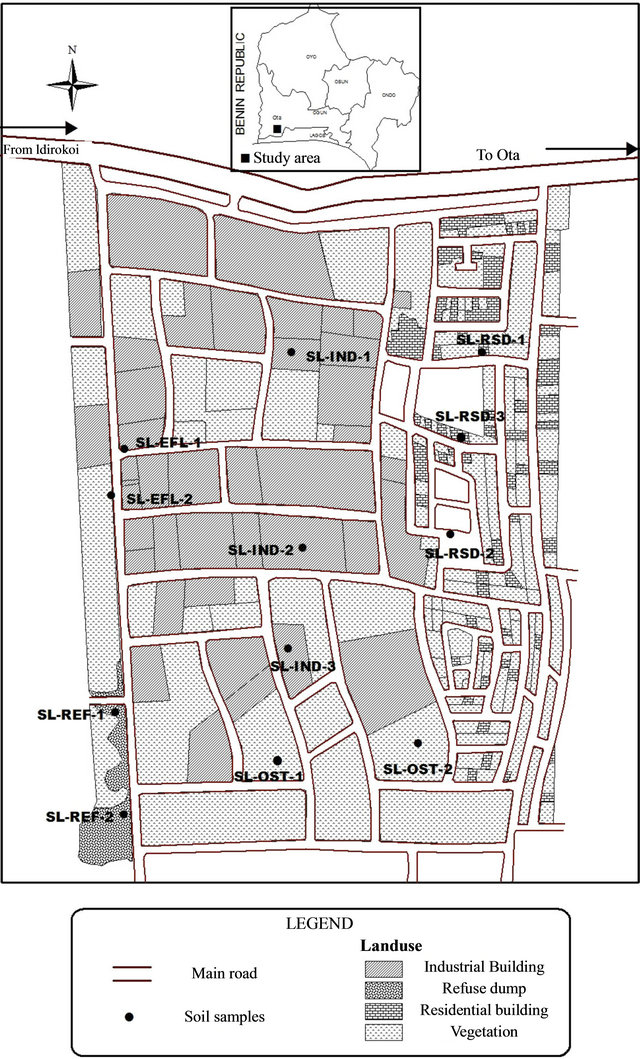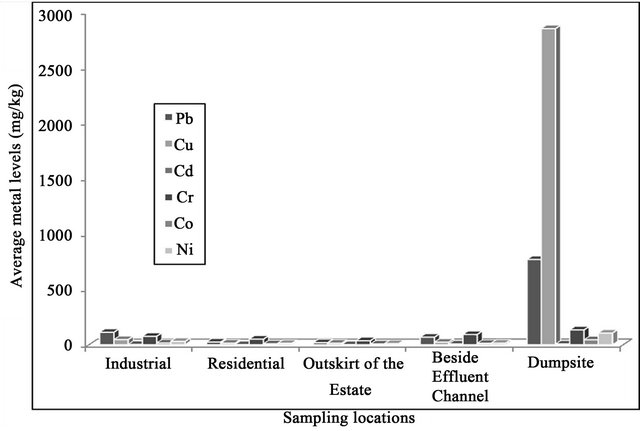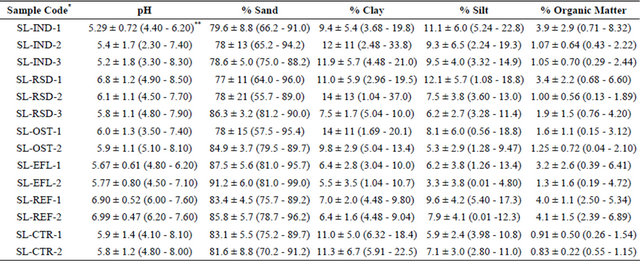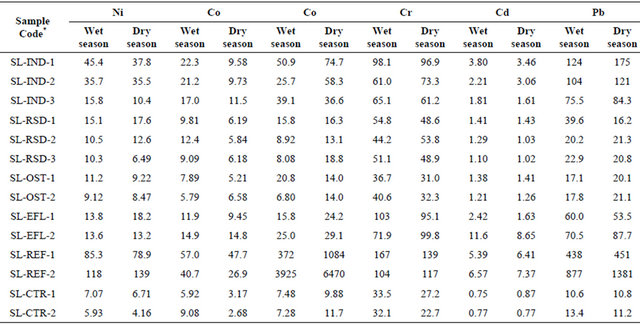Journal of Environmental Protection
Vol.4 No.1(2013), Article ID:27328,8 pages DOI:10.4236/jep.2013.41010
Heavy Metal Pollution of Topsoil in the Vicinity of an Industrial Estate Co-Located with a Housing Estate in Southwestern Nigeria
![]()
Department of Chemistry, University of Ibadan, Ibadan, Nigeria.
Email: etim242@yahoo.com
Received October 3rd, 2012; revised November 3rd, 2012; accepted December 2nd, 2012
Keywords: Heavy Metal; Soil Contamination; Industrial Estate; Industrial Waste Dumpsite
ABSTRACT
Heavy metals were determined in topsoils around a major industrial estate co-located with a housing estate in the southwestern region of Nigerian. Samples were collected on three-monthly basis for 18 months, from the industrial waste dumpsites, industrial area, residential area, around an effluent channel, outskirts of the estate and control sites. Average levels of Cu (2850 ± 3340 mg/kg), Pb (768 ± 450 mg/kg) and Ni (105 ± 30 mg/kg) at the dumpsites were significantly higher than other locations. At the industrial area and effluent channels, Pb and Cr levels were slightly elevated compared with other metals. Metal levels at the residential area and outskirts of the estate were about the levels in the control. Generally, the degree of contamination within the vicinity of the estate was of the order Cu > Pb > Ni > Cd > Co > Cr. Average total bioavailable (non-residual) fraction of the metals consisted of 52.0% of the metal load, with this fraction for Cd and Pb being 73.9% and 60.7% respectively. Topsoils around the dumpsite were evidently polluted with high levels of copper and lead. Seepage of leachate from the dumpsite has the potential of contaminating ground water reserves. Improper disposal of industrial solid wastes appears to be the likely source of metal pollution in the industrial estate. Heavy metal pollution in the estate can therefore be significantly reduced by prompt and proper disposal of generated solid wastes, and the application of particulate scrubbers in the industries.
1. Introduction
The mobilization of heavy metals into the biosphere through industrial activities is an important process in the geochemical cycling of metals. This is very evident in urban areas where various industrial sources release large quantities of heavy metals into the atmosphere and soil [1-5]. Some of the pathways of these metals into the soil are via dustfall [6-9], fly ash [10], slag and sludge [11] and solid waste. Several researchers have indicated the need for a better understanding of urban soil pollution [12-14] in relation to industrial activities. Similarly, more research has focused on heavy metals in urban soils around industrial sites [15-17]. Soil contamination by heavy metals has been shown to inhibit soil microbial activities [18,19], in turn reducing soil fertility and inhibiting the germination of certain seed plants [3,20]. Heavy metals contamination may also produce nutrient imbalance in plants with adverse effect on the synthesis and functioning of many biologically active compounds [21]. Subsequent accumulation of the metals in the food chain [3,22] is detrimental to human health.
Despite growing rates of industrialization, many developing third world countries pay too little attention to environmental issues. This is evident in the location of many industrial facilities near residential areas and the non-availability of adequate regulatory and enforcement measures to guard against pollution. One of such industrial facilities co-located with residential areas is the Ota Industrial/Housing Estate in the southwestern region of Nigeria (Figure 1). There are thirty nine different factories within the estate dealing with a wide range of products that include chemicals, pharmaceuticals, plastics, paper and pulp, and metals/steel. A third of these industries which represents the primary industrial types are metal-based industries, producing either iron rods, steel or galvanized pipes and sheets. Co-located with these industrial types at very close proximity are low cost residential houses. Emissions of particulates into the atmosphere, and improper disposal of solid wastes are common practices within the estate. This paper investigates the spatial and temporal patterns of heavy metal concentrations in topsoil, and estimates the degree of

Figure 1. Map of the Ota industrial/housing estate showing sampling locations.
pollution, using the accumulation factor (AF) values.
2. Methodology
2.1. Description of Study Locations
The Ota industrial/housing estate, located on latitude 6˚32'N and longitude 2˚57'E, is sited on a 22.8 km2 expanse of land in tropical southwestern region of Nigeria (Figure 1). It is characterized by high humidity with annual rainfall of 128 - 350 cm. The geology within this area is the coastal plain sedimentary formation characterized by sand, clay and silt [23]. The estate consists of two separated co-located segments; the industrial and residential areas. The distance separating the two segments is just about 20 m. The residential area which lies to the east of the estate occupy about one third of the total estate land space. A few thousands inhabitants reside in the residential area of the estate. Waste management in the estate is poor and untreated effluent is often discharge into poorly constructed channels that empty into a local stream. Solid waste piles litter the vicinities of the factories, and most of the factories have no emission control gadgets installed.
2.2. Sampling
Topsoils were sampled from three core industrial areas (SL-IND), three residential areas (SL-RSD), beside two liquid effluent channels (SL-EFL) and two refuse dumpsites (SL-REF). Two other locations were on the outskirt of the estate (SL-OST) where there were no waste dumps. Control samples were obtained from other residential areas located about 1 km from the industrial estate and not affected by industrial activities. Field sampling and analysis were conducted on a quarterly basis for a period of 18 months. Each sample was obtained by compositing surrounding topsoil into a polythene bag with the aid of a plastic scooping trowel.
2.3. Sample Processing and Analytical
The soils were air-dried in a clean room in the laboratory and then passed through a 2 mm mesh sieve. Soil pH was determined by the electrometric method using a 1:1 soilwater mixture [24]. The hydrometer method was used for measuring soil granulometric properties (sand, silt and clay), while the classical redox back-titrimetry procedure was used to determine soil organic matter content. For metal analysis, about 5.0 gram of dried soil was extracted with 50.0 ml of 2 M HNO3 in a covered glass bottle placed in a boiling water bath for 2 hours with shaking at intervals of 15 minutes, and subsequent filtration for metal analysis. This extraction method has been established to yield results for the ecologically significant fraction of the soil metal content [25]. A blank sample was incorporated for every batch of twenty soil samples processed. The filtrates were analyzed for lead, cadmium, chromium, cobalt, copper and nickel using an atomic absorption spectrophotometer (Buck Scientific, model 200A). Commercial BDH stock standards were used for instrument calibration. Speciation of metal contents was carried out by the sequential extraction scheme of Tessier et al. [26] applied to ten selected samples. The exchangeable fraction was extracted with magnesium chloride solution at pH 7.0, while carbonate fraction was extracted by leaching with 1M sodium acetate which had been adjusted to pH 5.0 with acetic acid. Reducible fraction was extracted with 0.04M NH2OH×HCl in 25% (v/v) acetic acid. Oxidizable fraction was determined by treatment of sample with 30% H2O2 adjusted to pH 2.0 with HNO3, while residual fraction was digested with a 2:1 mixture of concentrated hydrofluoric and perchloric acids. Reagent blanks were prepared and analysed for each extraction. Extracts were subsequently analysed for metals by atomic absorption spectrophotometry. A recovery study was carried out by spiking portions of five previously analyzed samples with standards of lead, chromium, copper, cobalt and nickel. These were then dried, homogenized and passed through the extraction and analytical steps. Mean percentage recoveries obtained were: Ni: 81.5% ± 19.8%, Cr: 100% ± 7%, Cu: 96.6% ± 7.3%, Pb: 100% ± 23% and Co: 96.1% ± 9.0%.
2.4. Data Treatment
Accumulation factor (AF) for each metal at each location was calculated to determine the degree of contamination at the sampling locations. This is the ratio of average metal concentration at any one sampling location to the concentration at the control point. The AF is a good index for assessing soil environmental quality [27-31]. In addition, analysis of variance (p = 0.05) was conducted to establish statistical relationships among metal concentrations at different sampling locations.
3. Results and Discussion
Metal concentrations in topsoil of the industrial estate are shown in Table 1. Average Cu (2850 ± 3340 mg/kg), Pb (768 ± 450 mg/kg) and Ni (105 ± 30 mg/kg) levels in dumpsite samples were significantly higher than the corresponding values around the industrial area, residential area, outskirt of the estate and beside the effluent channels (Tables 1 and 2, Figure 2). The industrial area and effluent channels recorded higher levels of Pb and Cr than other metals. Average levels of Pb, Cu, Cd, Cr, Co and Ni in the residential areas and the outskirt of the estate were about the same levels as in the control sites (Table 2, Figure 2). Table 3 shows results for the soil pH, organic matter and granulometric fractions. These are important for understanding the potential for translocation of contaminants within the soils of the study area. On the average, slightly acidic pH conditions exist in the topsoils, while the textural properties showed the soil to be mostly sandy. The average soil organic carbon is relatively low. These characteristics will enhance metal mobility in the soil with the associated risk of pollutants migrating into ground water reserve, and being bioavailable to plants. Analysis of variance (p = 0.05) showed no significant seasonal variation in metal levels in the topsoil (Table 4). However, Cu levels at the dumpsite were slightly higher in the dry season.
Table 5 shows the accumulation factors of the metals in the topsoil. The dumpsite showed a high degree of contamination with AF values of 322, 66.2 and 17.2 for Cu, Pb and Ni respectively. The degrees of pollution re-

Figure 2. Colum chart showing heavy metal distribution in various locations.
Table 1. Metal concentrations (mg/kg) in topsoil of the industrial estate.

*SL-IND—industrial area, SL-RSD—residential area, SL-OST—outskirt of the estate, SL-EFL—beside effluent channels, SL-REF—dumpsite, SL-CTR— control. See Figure 1. **Mean ± Standard Deviation (Range).
Table 2. Summary of average metal concentrations (mg/kg) in topsoil of the industrial estate.

Table 3. pH, granulometric fractions and organic matter contents of the soils.

*SL-IND—industrial area, SL-RSD—residential area, SL-OST—outskirt of the estate, SL-EFL—beside effluent channels, SL-REF—dumpsite, SL-CTR— control. **Mean ± Standard Deviation (Range).
Table 4. Average seasonal metal concentrations (mg/kg) in topsoil of the industrial estate.

*SL-IND—industrial area, SL-RSD—residential area, SL-OST—outskirt of the estate, SL-EFL—beside effluent channels, SL-REF—dumpsite, SL-CTR— control.
corded here are much higher than previously observed at another industrial estate in the nearby city of Lagos where the corresponding AF values were 15.0, 28.1 and 13.1 [29]. In the vicinity of an auto-battery manufacturing industry in another nearby city of Ibadan, only Pb showed a significant factor of accumulation of 175 [32]. Generally, the degree of contamination within the vicinity of the estate was of the order Cu > Pb > Ni > Cd > Co > Cr (Table 5).
Table 6 shows the results of the speciation study. Average bioavailable (non-residual) fraction was: Pb-60.7%, Cd: 73.9%, Cr: 32.4%, Cu: 47.8%, Co: 50.6% and Ni: 46.8%. The most mobile of the bioavailable phases, the exchangeable phase, was generally less than 8.0% with Cu having the lowest value of 0.02%. A greater proportion of Cr, Cu and Ni (>50%) was in the residual phase. The proportion held in the carbonate-bound, reducible and oxidizable phases were generally higher than in the exchangeable phase. Environmental factors that tend to reduce soil pH will readily mobilize these fractions. Similarly, changes in soil redox potential and soil redox reaction will influence the release and retention of elements in these phases [33]. The low proportion of Cu in the exchangeable and reducible phases will reduce its bioavailability in the soil. The low proportion of residual and exchangeable Pb and Cd in the soil indicates a high affinity of these metals to complexation with organic and inorganic substances in soil Soil quality criteria have not yet been established for Nigeria. Metal levels obtained from this study are therefore compared with soil quality criteria for Canada [34], Norway [35], Netherland and Switzerland [35,36] (Table 7). These soil quality criteria address the important areas assessed by this study. The overall average Pb (199
Table 5. Accumulation factors of metals in topsoil of the industrial estate.

Table 6. Average speciation (% in geochemical phases) of the metals.

Table 7. Soil quality criteria for some countries compared with level (mg/kg) obtained from this study.

mg/kg) and Cu (589 mg/kg) levels in this study exceed the Norwegian and Swiss guide values. Average Pb, Cu, Cd, Cr and Ni in the residential and industrial areas of the study area in Table 2 were within the Canadian soil limits for residential and industrial areas respectively. However, three sampling locations in the residential area had elevated Cr level and fifteen sampling locations in the industrial area had concentrations of Cr, Cu and Ni exceeding the Canadian soil standards. The dumpsite area recorded average Pb and Cu levels above the Netherlands action level.
Average metal levels in this study were compared to those obtained in other areas with similar industrial activities. Average Pb level (199 mg/kg) in this study is higher than the 102 mg/kg reported for soils of the Upper Silesia industrial environment in South Poland [37], 172 mg/kg in contaminated soil in Albania [1] and 170 mg/kg in the greater Sofia industrial region of Bulgaria [4]. However, the level was below 552 mg/kg reported for the surrounding of a smelter at Copsa-Mica in central Romania [38], 293 mg/kg in the Pali industrial development area of Rajasthan, India and 2000 mg/kg in the vicinity of a lead-battery factory in Ibadan, Nigeria [32]. Average levels of Cu (589 mg/kg), Cd (3.52 mg/kg), and Co (17.6 mg/kg) in the study are much lower than the corresponding 1107 mg/kg, 3865 mg/kg, and 14 mg/kg obtained in contaminated soil in Albania [1].
The study reveals that heavy metal pollution of topsoil is significant in the industrial estate. It also points to wastedumping as the most important source of the contamination. The soil characteristics may enhance migration of the metal contaminants into ground water, although the exchangeable fraction is limited. Preventive and remediation actions may be required to reduce present levels of contamination to within safe limits. Such actions must focus on the identified dumpsite point sources, in addition to other measures. This may be managed by prompt and proper disposal of solid wastes, installation of particulate scrubbers, and regular monitoring of soil quality to comply with regulatory standards.
REFERENCES
- S. Shallar, C. Schwartz, A. Hasko and J. L. Morel, “Heavy Metals in Soils and Plants of Serpentine and Industrial Sites of Albania,” Science of the Total Environment, Vol. 209, No. 2-3, 1998, pp. 133-142.
- C. Bilos, J. C. Colombo, C. N. Skorupka and M. J. P. Presa, “Source, Distribution and Variability of Airborne Trace Metals in La Plata City Area, Argentina,” Environmental Pollution, Vol. 111, No. 1, 2001, pp. 149-158. doi:10.1016/S0269-7491(99)00328-0
- P. Senthilkumar, W. S. P. M. Prince, S. Sivakumar and C. V. Subbhuraam, “Prosopis Juliflora—A Green Solution to Decontaminate Heavy Metal (Cu and Cd) Contaminated Soils,” Chemosphere, Vol. 60, No. 10, 2005, pp. 1493-1496. doi:10.1016/j.chemosphere.2005.02.022
- S. Rainer, C. Fabien, M. Margarita, D. Angelina and K. Armin, “Heavy Metal Contamination along a Soil Transect in the Vicinity of the Iron Smelter of Kremikovtzi (Bulgaria),” Geoderma, Vol. 140, No. 1-2, 2007, pp. 52- 61. doi:10.1016/j.geoderma.2007.03.007
- D. Y. Ozan, A. Omar and T. Gurdal, “Multivariate Statistics to Investigate Metal Contamination in Surface Soil,” Journal of Environmental Management, Vol. 86, No. 4, 2008, pp. 581-594. doi:10.1016/j.jenvman.2006.12.032
- J. Cyrys, M. Stolzel, J. Heinrich, W. G. Kreyling, N. Menzel, K. Wittmaack, T. Tuch and H. E. Wichmann, “Elemental Composition and Sources of Fine and Ultra Fine Ambient Particles in Erfurt, Germany,” Science of the Total Environment, Vol. 305, No. 1-3, 2003, pp. 143- 156. doi:10.1016/S0048-9697(02)00494-1
- C. W. Gray, R. G. McLaren and A. H. C Roberts, “Atmospheric Accessions of Heavy Metals to Some New Zealand Pastoral Soils,” Science of the Total Environment, Vol. 305, No. 1-3, 2003, pp. 105-115. doi:10.1016/S0048-9697(02)00404-7
- S. H. Naim, O. Kurtulus, D. Goksel, N. Semih and B. Cuma, “Determination of Heavy Metal Concentrations in Street Dust in Istanbul E-5 Highway,” Environment International, Vol. 29, No. 7, 2004, pp. 979-985. doi:10.1016/S0160-4120(03)00075-8
- M. Emanuela, V. Daniela and D. Gaetano, “Metal Distribution in Road Dust Samples Collected in an Urban Area Close to a Petrochemical Plant at Gela, Sicily,” Atmospheric Environment, Vol. 40, No. 30, 2006, pp. 5929-5941. doi:10.1016/j.atmosenv.2006.05.020
- D. Schulze, H. Kruger, C. Segebade and D. Gawlik, “Enrichment and Distribution of Elements in Floodplain Soils of the Bitterfeld Industrial Area Studied by Neutron Activation Analysis”, Science of the Total Environment, Vol. 206, No. 2-3, 1997, pp. 227-248.
- J. B. E. Patterson, “Metal Toxicity Arising from Industry,” In: M. Webb, Ed., Trace Elements in Soils and Crops, MAFF Technical Bull, No. 21, Her Majesty’s Stationary Office, London, 1971, pp. 193-207.
- C. R. De Kimple and J. F. Morel, “Urban Soil Management: A Growing Concern,” Soil Science, Vol. 165, No. 1, 2000, pp. 31-40. doi:10.1097/00010694-200001000-00005
- D. S. Manta, M. Angelone, A. Bellanca, R. Neri and M. Sprovieri, “Heavy Metals in Urban Soils: A Case Study from the City of Palermo (Sicily), Italy,” Science of the Total Environment, Vol. 300, No. 1-3, 2002, pp. 229-243. doi:10.1016/S0048-9697(02)00273-5
- O. S. Rossini and E. A. J. Fernandez, “Monitoring of Heavy Metals in Topsoils, Atmospheric Particles and Plant Leaves to Identify Possible Contamination Sources”, Microchemistry Journal, Vol. 86, No. 1, 2007, pp. 131- 139. doi:10.1016/j.microc.2007.01.003
- J. Kelly, I. Thornton and P. R. Simpson, “Urban Geochemistry: A Study of the Influence of Anthropogenic Activity on the Heavy Metal Content of Soils in Traditionally Industrial and Non-Industrial Areas of Britain,” Applied Geochemistry, Vol. 11, No. 1-2, 1996, pp. 363- 370. doi:10.1016/0883-2927(95)00084-4
- H. W. Mielke, C. R. Gonzales, M. K. Smith and P. W. Mielke, “The Urban Environment and Children’s Health: Soils as an Integrator of Lead, Zinc and Cadmium in New Orleans, Louisiana, USA,” Environmental Research, Vol. 81, No. 2, 1999, pp. 117-129. doi:10.1006/enrs.1999.3966
- A. K. Krishna and P. K. Govil, “Heavy Metal Contamination of Soil around Pali Industrial Area, Rajasthan, India,” Environmental Geology, Vol. 47, No. 1, 2004, pp. 38-44. doi:10.1007/s00254-004-1124-y
- M. W. Yim and N. F. Y. Tam, “Effect of Waste WaterBorne Heavy Metals on Mangrove Plants and Soil Microbial Activities,” Marine Pollution Bulletin, Vol. 39, No. 1-12, 1999, pp. 179-186.
- S. Nosir, P. Stanislav and S. Yosef, “The Impact of the Almalyk Industrial Complex on Soil Chemical and Biological Properties,” Environmental Pollution, Vol. 136, No. 2, 2005, pp. 331-340. doi:10.1016/j.envpol.2004.12.007
- L. K. Chugh and S. K. Sawhney, “Effect of Cadmium on Germination, Amylase and Rate of Respiration of Germination Pea Seed,” Environmental Toxicology, Vol. 134, No. 6, 1996, pp. 45-61.
- N. A. Cherngkh, “Alteration of the Concentration of Certain Elements in Plants by Heavy Metal in the Soil,” Soviet Soil Science, Vol. 23, No. 6, 1991, pp. 45-53.
- F. M. Johnson, “The Genetic Effects of Environmental Lead,” Journal of Environmental Toxicology, Vol. 410, No. 2, 2004, pp. 123-140.
- H. A. Jones and R. D. Hockey, “The Geology of Part of Southwestern Nigeria,” Bulletin (Geological Survey of Nigeria), Vol. 31, 1964, p. 87.
- International Institute of Tropical Agriculture, “Selected Methods for Soil and Plant Analysis,” Manual Series, No. 1, IITA, Ibadan, 2001.
- A. Andersson, “On the Determination of Ecologically Significant Fractions of Heavy Metals in Soils,” Swedish Journal of Agricultural Research, Vol. 6, 1976, pp. 19- 25.
- A. Tessier, P. G. C. Campbell and M. Bisson, “Sequential Extraction Procedures for the Speciation of Particulate Trace Metals,” Analytical Chemistry, Vol. 51, No. 7, 1979, pp. 844-881. doi:10.1021/ac50043a017
- K. Ju-Yong, K. Kyoung-Woong, L. Jong-Un, L. Jin-Soo and C. Jenny, “Assessment of as and Heavy Metal Contamination in the Vicinity of Duckum Au-Ag mine, Korea,” Environmental Geochemistry, Vol. 24, No. 3, 2001, pp. 213-225.
- P. C. Onianwa, “Roadside Topsoil Concentrations of Lead and Other Heavy Metals in Ibadan, Nigeria,” Soil and Sediment Contamination, Vol. 10, No. 6, 2001, pp. 577-591. doi:10.1080/20015891109446
- S. O. Fakayode and P. C. Onianwa, “Heavy Metal Contamination of Soil, and Bioaccumulation in Guinea Grass (Panicum Maximum) around Ikeja Industrial Estate, Lagos, Nigeria,” Environmental Geology, Vol. 43, No. 1-2, 2002, pp. 145-150. doi:10.1007/s00254-002-0633-9
- T.-B. Chen, Y.-M. Zheng, M. Lei, Z.-C. Huang, H.-T. Wu, H. Chen, K.-K. Fan, K. Yu, X. Wu and Q.-Z. Tian, “Assessment of Heavy Metal Pollution in Surface Soils of Urban Parks in Beijing, China,” Chemosphere, Vol. 60, No. 4, 2005, pp. 542-551. doi:10.1016/j.chemosphere.2004.12.072
- W.-H. Liu, J.-Z. Zhao, Z.-Y. Ouyang, L. Söderlund and G.-H. Liu, “Impacts of Sewage Irrigation on Heavy Metal Distribution and Contamination in Beijing, China,” Environment International, Vol. 31, No. 6, 2005, pp. 805-812. doi:10.1016/j.envint.2005.05.042
- P. C. Onianwa, O. M. Jaiyeola and R. N. Egekenze, “Heavy Metals Contamination of Topsoil in the Vicinities of AutoRepair Workshop, Gas Stations and Motor-Parks in a Nigerian City,” Toxicology and Environmental Chemistry, Vol. 84, No. 1-4, 2001, pp. 33-39. doi:10.1080/02772240309820
- R. Charlatchka and P. Cambier, “Influence of Reducing Conditions on Solubility of Trace Metals in Contaminated Soils,” Water Air and Soil Pollution, Vol. 118, No. 1-2, 2000, pp. 143-168. doi:10.1023/A:1005195920876
- Canadian Council of Ministers of the Environment, “Canadian Soil Quality Guidelines for the Protection of Environmental and Human Health: Summary Tables,” In: Canadian Environmental Quality Guidelines, Canadian Council of Ministers of the Environment, Winnipeg, 2007.
- C. Reimaan, R. Boyd, P. De Caritat, J. K. Halleraker, G. Kashulina, H. Niskavaara and L. Bogatyrev, “Topsoil (0 – 5 cm) Composition in Eight Arctic Catchment in Northern Europe (Finland, Norway and Russia),” Environmental Pollution, Vol. 98, No. 2, 1997, pp. 45-56. doi:10.1016/S0269-7491(96)00102-9
- Federal Office of Environment, Forest and Landscape, “Commentary on the Ordinance Relating to Pollutants in Soil (VSBo of 9 June 1986),” Federal Office of Environment, Forest and Landscape, Bern, Switerzland, 1987.
- S. Dudka, M. Piotrowska, A. Chlopecka and T. Witek, “Trace Metal Contamination of Soil and Crop Plants by the Mining and Smelting Industry in Upper Silesia, South Poland,” Journal of Geochemical Exploration, Vol. 52, No. 1-2, 1995, pp. 237-250. doi:10.1016/0375-6742(94)00047-F
- C. Rauta, A. Mihailescu, S. Carstea, M. Toti, G. Neata, E. Gument, G. Mihalache, F. Dumitrescu, C. Zelinschu and H. Dancau, “Industrial Pollution of Soils and Forests in the Copsa-Mica Area of Romania,” Analele Institutului de Cercetari Pentru Pedologie si Agro, Vol. 48, 1988, pp. 269-280.
NOTES
*Corresponding author.

